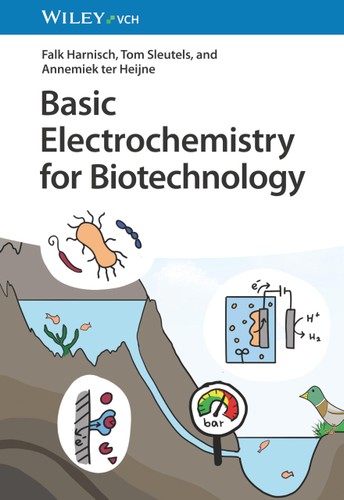

Most ebook files are in PDF format, so you can easily read them using various software such as Foxit Reader or directly on the Google Chrome browser.
Some ebook files are released by publishers in other formats such as .awz, .mobi, .epub, .fb2, etc. You may need to install specific software to read these formats on mobile/PC, such as Calibre.
Please read the tutorial at this link: https://ebookbell.com/faq
We offer FREE conversion to the popular formats you request; however, this may take some time. Therefore, right after payment, please email us, and we will try to provide the service as quickly as possible.
For some exceptional file formats or broken links (if any), please refrain from opening any disputes. Instead, email us first, and we will try to assist within a maximum of 6 hours.
EbookBell Team

0.0
0 reviews
ISBN 10: 3527348085
ISBN 13: 9783527348084
Author: Falk Harnisch, Tom Sleutels, Annemiek ter Heijne
Basic Electrochemistry for Biotechnology
Understand the basics of a thriving interdisciplinary research field
Microbial electrochemistry is a subfield of bioelectrochemistry which concerns interactions between microbial organisms and electrically active surfaces such as electrodes. Its growth as a subject of research has been rapid in recent years, and its technological applications are many, particularly as the race to find sustainable organic energy sources accelerates.
Basic Electrochemistry for Biotechnology offers an accessible overview of this interdisciplinary subject and its potential applications. Moving smoothly from the general to the specific, it offers both fundamental principles and some of the most relevant specific examples, such as biofilm electrodes, microbial fuel cells or microbial electrosynthesis cells, making it the ideal choice for building a working knowledge of this exciting new field. Its solid foundation of microbial electrochemical technologies also serves as a starting point for a wide range of applied research areas.
Basic Electrochemistry for Biotechnology readers will also find:
Basic Electrochemistry for Biotechnology is the perfect point of entry into this growing field for both students and researchers.
1 A Reader's Guide to Basic Electrochemistry for Biotechnology
2 A Basic Introduction to Microbial Electrochemical Technologies
2.1 Introduction to Microbial Energy Conversion and Microbial Electrochemical Technologies
2.2 Electroactive Microorganisms and Mechanisms of Extracellular Electron Transfer
2.3 Energetics: The Redox Tower and a Water Analogy
2.4 Wastewater Characteristics
2.5 Microbial Electrochemical Technologies: Systems and Design
2.6 Short Alert on Terminology
Questions
References
Note
3 Electrochemical Potential, Electrode Potential, and the Need for Reference Electrodes
3.1 Introduction to Electrochemical Potentials
3.2 Electrodes and Electrode Reactions
3.3 The Relative Electrode Potential and the Need for Reference Electrodes
Questions
References
Notes
4 Reaction Equations and Thermodynamics of Electrochemical Reactions
4.1 Introduction to Oxidation and Reduction Reactions and Thermodynamic Limits
4.2 How to Write and Balance Reaction Equations of (Bio)electrochemical Reactions
4.3 Thermodynamics of Electrochemical Conversions
Questions
References
Notes
5 Static Electrochemical Methods
5.1 Introduction to Static Electrochemical Methods
5.2 What Is a Three‐Electrode Arrangement, a Potentiostat or Power Supply, and for What Are They Needed?
5.3 The Electrochemical Double Layer and Capacitive Current
5.4 Potentiometry, Amperometry, Coulometry, and Constant Current Measurements
5.5 Chronoamperometry
Questions
References
Notes
6 Electrochemical Kinetics
6.1 Introduction to Electrochemical Kinetics
6.2 Basics of Electrochemical Kinetics
6.3 Electrochemical Reversibility
6.4 Overpotentials
6.5 The Overpotential Due to Mass Transfer
6.6 Potential‐Current Plots and Electrode Kinetics
6.7 The Butler–Volmer Equation
6.8 Tafel Equation and Tafel Plots
6.9 Electrocatalysis
Questions
References
Notes
7 Dynamic Electrochemical Methods
7.1 Introduction to Electrochemical Methods with Changing Electrode Potential
7.2 Voltammetry
7.3 Performing Dynamic Electrochemical Methods Using Potentiostats: Discriminating Capacitive and Faradaic Current
7.4 Cyclic Voltammetry
7.5 Redox‐Active Components in Microorganisms
7.6 Acquisition of Polarization and Power Curves Using Stepwise Chronoamperometry and Chronopotentiometry
7.7 Acquisition of Polarization Curves Using External Resistance
7.8 Electrochemical Impedance Spectroscopy
Questions
References
Notes
8 Electrochemical Analysis of Reactors
8.1 Introduction to Characterization of Microbial Electrochemical Cells
8.2 Mass and Electron Balances and Efficiency of Conversions
8.3 Polarization and Power Curves: Analysis of Measured Data
8.4 Internal Resistance and Potential Losses
8.5 Energy Efficiency and Voltage Efficiency
8.6 Ionic Current and Transport Numbers
Questions
References
Notes
9 Seizing the Beauty and Acknowledging the Complexity of Basic Electrochemistry for Biotechnology
Note
Appendix A: Abbreviations
basic electrochemistry for biotechnology pdf
what is basic biotechnology
biotechnology elective
electrochemistry for beginners
electrochem basics
Tags: Falk Harnisch, Tom Sleutels, Annemiek ter Heijne, Electrochemistry